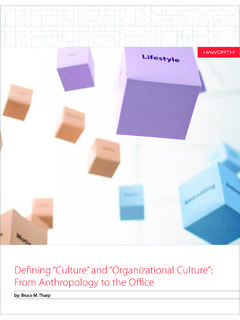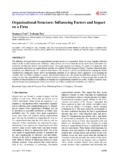Transcription of ARIS Enterprise Architecture Solution - ARISE …
1 Business Process ExcellenceWhite Paper - March 2006 ARIS Enterprise Architecture Solution2 IDS Scheer AG March 2006 Table of contents1 Introduction .. Architectures .. of Architecture .. of the Enterprise Architecture .. of Enterprise Architecture .. Architectures .. Business Process Architecture .. Organizational Architecture .. Business Performance Architecture .. Frameworks .. Zachman Framework .. ARIS Framework .. TOGAF Framework .. FEAF Framework .. Tool Requirements .. of architectures .. capabilities .. capabilities .. Platform .. to Architecture .. role .. properties .. role ..197 Conclusions.
2 208 Literature ..21 List of figuresFig. 1:The Classic Enterprise Architecture ..6 Fig. 2:The Y-CIM Model ..8 Fig. 3:The Zachman Framework ..11 Fig. 4:The ARIS Framework ..13 Fig. 5:The Balanced Enterprise Architecture Framework ..16 IDS Scheer AG March 200634 IDS Scheer AG March 20061 IntroductionThe concept of Enterprise Architecture has been around for quite some time. However, it gained considerablemomentum at the beginning of this century for a variety of reasons. Perhaps the most important was an acceler-ation of environmental changes for organizations in all industries. The concept of organizational agility was coinedas a strategic imperative.
3 In other words, the capability to detect environmental change and respond effectivelyto that change became a condition for long-term survival and and effective changes are not possible today without changes in IT application systems and it turned out, in many companies relationships and interfaces between applications were not properly docu-mented and understood to facilitate planning and implementation of required changes. Application integrationefforts required extensive analysis and took longer than expected. In other companies, the same was true for man-ual activities and information flows. Actually, any larger-scale change in business processes runs into a risk ofunintended consequences and side effects.
4 Elsewhere, due to e-business requirements, there was a need to stan-dardize inter-organizational business processes. This was also difficult because details of external relationshipswere not formalized. The need to describe Enterprise elements and their interrelationships, as well as to analyze them, became appar-ent in the business and IT domains. The growing interest in tools to support Architecture efforts was noticed bysoftware vendors. However, around 70% of enterprises use office automation and drawing tools to support enter-prise Architecture projects1. To a large extent, it is closely coupled with a low degree of maturity in this experts predict that this will change in the nearest future and more organizations will use sophisticatedtools to support their efforts.
5 The objective of this white paper is therefore to position ARIS Platform within theEnterprise Architecture (EA) Solution space. of architectureThere are many competing, technically-oriented definitions of Architecture . The IEEE RecommendedPractice for Architectural Description of Software-Intensive Systems (IEEE Std 1471-2000) defines architec-ture as .. the fundamental organization of a system embodied in its components, their relationships toeach other, and to the environment, and the principles guiding its design and evolution. 2 Architecture istherefore defined as a property of an object. Other definition explains the meaning of Architecture as a.
6 Well defined form of system description in terms of components, connections and composite structures. 3In this definition, Architecture is understood as an object of its own right. It is this definition that is mostpopular and commonly used. Such conceptual differences, while fundamental, are probably of little concern for practitioners, who dealwith architectural descriptions and artifacts anyway. More important in practice is a difference between adescriptive and a prescriptive meaning of Architecture . Gartner Group defines Architecture using two alter-native definitions as: An overall concept employed in creating a system, also an abstraction or design of a system, namelyits structure, components and how they interrelate A family of guidelines (concepts, principles, rules, patterns, interfaces and standards) to use whenbuilding a new IT alternative, the two architectures as defined above are closely related.
7 As interpreted using thefirst definition, Architecture is a description of something that exists or is planned. In this meaning, archi-tectural descriptions are used for analysis and planning purposes. Architecture in the second interpretationis used to support the transition process from the present state to the future one. The guidelines guidebehavior and facilitate decision-making along the of the Enterprise ArchitectureThis white paper is focused on descriptive architectures. Using such interpretation, the EnterpriseArchitecture is an abstraction of an Enterprise , namely its elements of various types and their interrelation-ships.
8 The classic Enterprise Architecture originated within IT industry is commonly partitioned into fourparts or subsets: The Business Architecture , which defines the business strategy, governance, organizational structuresand business processes. The Applications Architecture , which provides a blueprint for the individual application systems to bedeployed, their interactions and relationships with the supported business processes. The Data Architecture , which describes the structure of an organization s logical and physical dataassets, as well as data management resources. The Technology Architecture , which defines the software, hardware and network infrastructure intend-ed to support the application systems and second subset is sometimes called the Software Architecture , the third is frequently called theInformation Architecture , while the fourth one is also called the Infrastructure Architecture .
9 The classicEnterprise Architecture as understood today is illustrated in Figure 1. It must be emphasized though thatits current shape is a result of many years of bottom-up evolution. IDS Scheer AG March 200656 IDS Scheer AG March of Enterprise ArchitectureDuring the early days of Enterprise -wide computing architectural efforts targeted technology architectures. Thefocus was on purely technical standards and principles, as well as descriptions. Later on, the concept ofEnterprise-wide Information Technology Architecture (EWITA) was born. The concept included Application, Dataand Technology Architectures.
10 Therefore, the Enterprise Architecture became software and application develop-ment oriented. However, it was still not enough. It was realized that one cannot bypass business processes andrequirements during design of IT solutions . Therefore, to ensure effective mappings and requirements tracing, theBusiness Architecture was incorporated into the merging of business and IT concepts was a big step forward towards the holistic Enterprise , the resulting architectures were still technically oriented in practice. Generally, business elements suchas functions, processes, organizational units and users were taken into consideration only to justify and align ITsolutions with business needs better than before.






